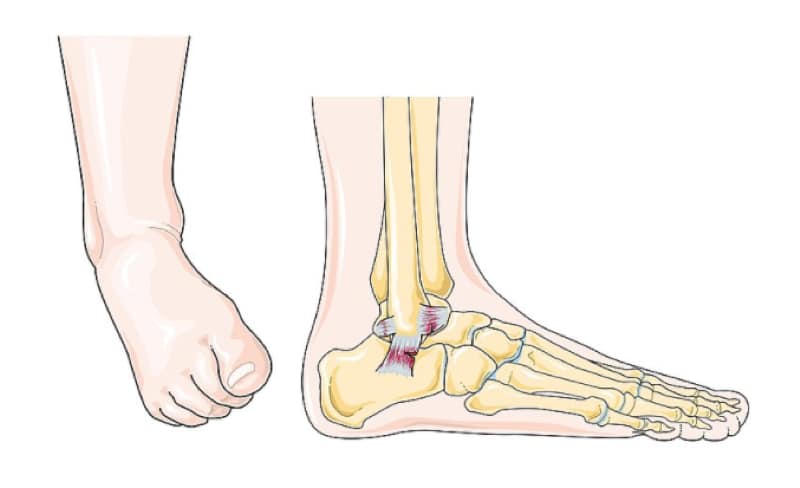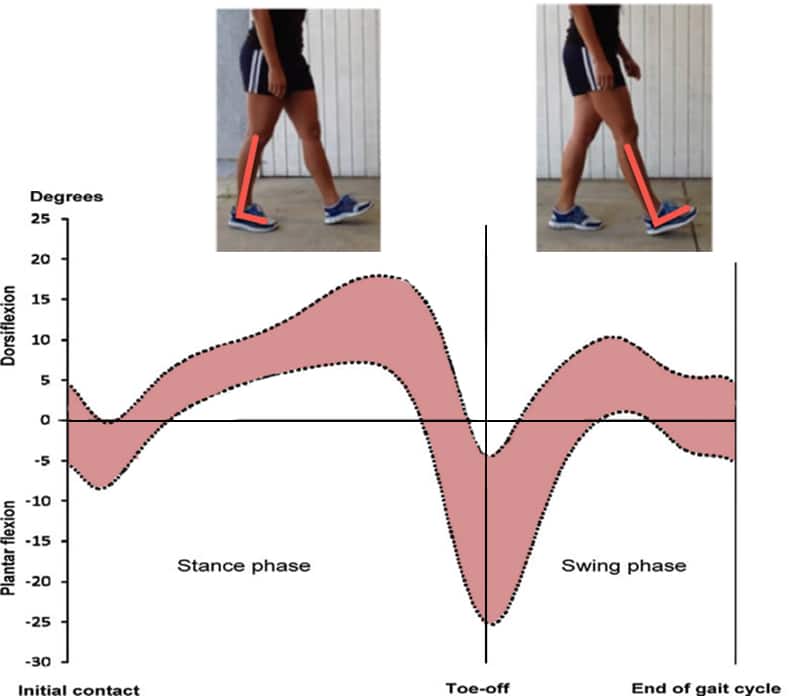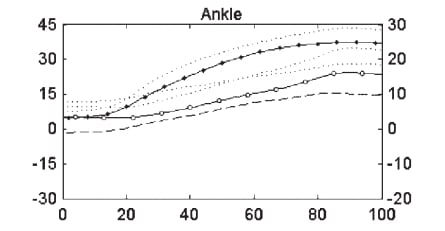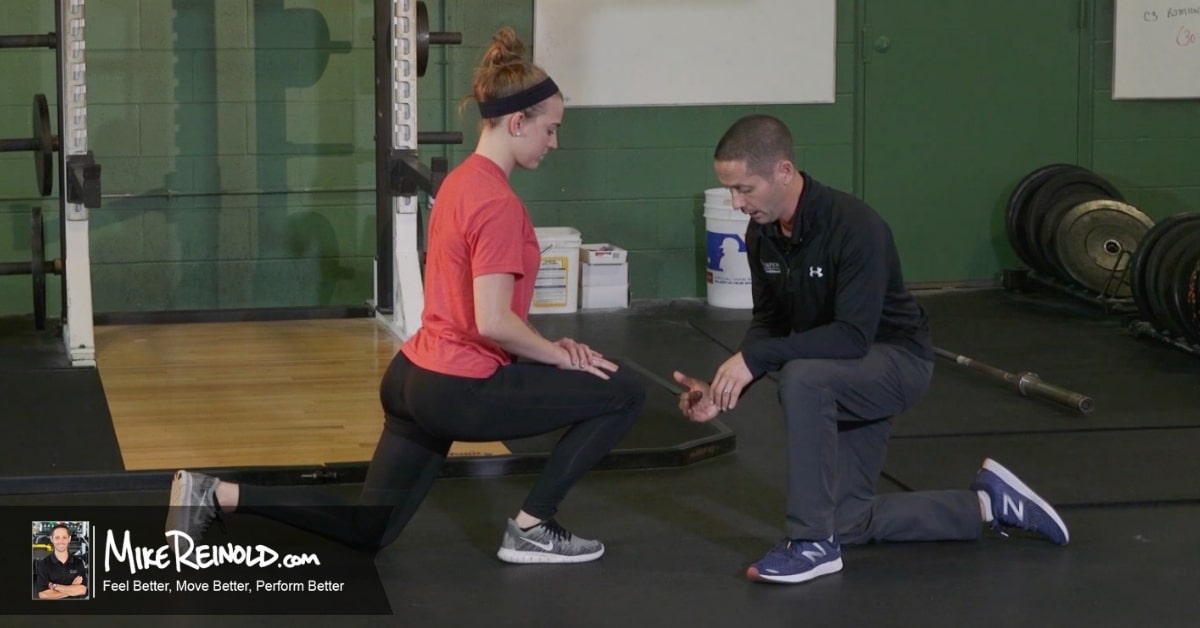Limitations in ankle dorsiflexion can cause quite a few functional and athletic limitations, leading to the desire to perform ankle mobility exercises.
These types of ankle mobility drills have become popular over the last several years and are often important components of corrective exercise and movement prep programming.
In this article, I’m going to cover everything you need to know about improving ankle dorsiflexion, including:
- What causes poor ankle dorsiflexion?
- Why limited ankle dorsiflexion can be a problem
- What is normal range of motion for ankle dorsiflexion?
- How much dorsiflexion range of motion do you need?
- How to assess your ankle mobility
- My 3-step approach to ankle dorsiflexion exercises to optimize mobility
What Causes Poor Ankle Dorsiflexion?
Before we get too deep into discussing how to fix poor ankle dorsiflexion, it helps to understand what could cause poor ankle mobility.
In my experience, the most common reason people may have poor dorsiflexion is a past surgery or injury.
This makes sense when dealing with big injuries, such as fractures, Achilles tendon ruptures, and ligament tears from acute sprains. Anything that requires a period of immobilization of the foot can obviously lead to a loss of ankle mobility.
But you don’t need to have a major injury or surgery, even mild injuries can lead to a loss of ankle mobility.
Ankle sprains, even mild degrees, seem to be an injury that frequently leads to a loss of dorsiflexion range of motion.
If you look at the anatomy of the anterior talofibular ligament, otherwise known as the ATFL, you can see that it attaches to both the fibula and the talus:

Any disruption of the ATFL ligament will lead to increased translation of the ankle, and even a more anteriorly positioned fibula. A 2006 study in JOSPT and a 2014 Study in JOSPT have both confirmed that subjects with chronic ankle instability had an altered position of the fibula.
It’s also been shown that scarring of the ATFL ligament can cause anterior ankle impingement. This is why people often feel a pinch in their anterior ankle when they dorsiflex.
But even if you haven’t sprained your ankle, activities with repetition dorsiflexion, such as sports that involve a lot of running and jumping, can also lead to adaptive changes and anterior ankle impingement.
As always, another factor can be our postural adaptations and terrible shoe wear habits, especially if high heels. Remember the body adapts to stress applied and stress NOT applied. It’s no wonder that so many people have ankle mobility issues. So the concept of “use it or lose it” can be a factor for those that don’t perform a lot of daily activities that need dorsiflexion.
Why Limited Ankle Dorsiflexion Can be a Problem
Several studies have been published that shown that limited dorsiflexion impacts many of our functional movement patterns, such as the squat, single-leg squat, lateral step down, and even landing from a jump.
This is likely due to the kinetic chain effect on the body. Here’s an example of some of the compensations with see with the lateral step down portion of the Champion Performance Specialist movement assessment:
When assessing a wide variety of studies in a systematic review, Lima found that limited ankle dorsiflexion is correlated with dynamic knee valgus angles during functional movements.
This can have obvious implications as a lack of dynamic knee valgus is associated with a variety of injuries, including ACL tears and patellofemoral pain. In fact, in one study, patients with patellofemoral osteoarthritis had less ankle dorsiflexion than those without arthritis.
What is Normal Range of Motion for Ankle Dorsiflexion?
The generally accepted normal range of motion for ankle dorsiflexion is 20 degrees as defined by both the American Academy of Orthopaedic Surgeons and the American Medical Association.
However, there is a lot of variability if you search the literature.
Benhamu showed between 13-21 degrees, Rome showed between 8-26 degrees, and Weir showed between 12 and 23 degrees of dorsiflexion their respective studies.
Baggett compared normal dorsiflexion range of motion in a non-weight bearing and weightbearing position, showing 0-17 in non-weightbearing and 7-35 degrees in weightbearing. Rabin also reported a large difference in dorsiflexion when comparing these two positions, however, they also noted a moderate correlation, meaning that a limitation in either position will likely show up in both.
With such a wide variety of methods of measuring and reported values, the bigger question may be how much dorsiflexion mobility do you need?
How Much Dorsiflexion Range of Motion Do You Need?
The ability to have a proper amount of dorsiflexion isn’t something that is only needed in sports, it’s actually a vital movement to allow normal functional activities.
Walking has been shown to require approximately 10 degrees of ankle dorsiflexion by Dr. Jacqueline Perry in her gait research. As the body advances, the trail leg needs to dorsiflex as the hip extends right before push off.

More recent research has reported that up to 20 degrees of dorsiflexion has been shown in subjects during gait analysis.
More dynamic movements, such as the squat, require even more ankle dorsiflexion range of motion. A 2006 study by Hemmerich in the J Orthop Res showed that the further you go into the squat position, the more dorsiflexion motion is needed. Maximal squat depth to just past parallel requires almost 35 degrees of dorsiflexion.


As you can see in the images above, once you get deeper than 20-30 degrees of squat depth, the amount of dorsiflexion needed goes up considerably. The first image is depicting someone with a restriction with ankle dorsiflexion, and how that will impact the depth of the squat. In the second image, you can see how having more dorsiflexion will improve the depth of the squat. The third photo shows an example of modifying the squat by elevating the heels. This take some of the dorsiflexion needs out of the squat to allow her to go deeper.
Check out this video demonstration on how to improve the squat with limited ankle dorsiflexion to see how we would coach this:
Ever wonder why weightlifting shows have a large heel lift? Well, it’s to squat deeper by taking out the need for so much dorsiflexion. In my experience, a lack of dorsiflexion is one of the biggest reasons why people often squat poorly.
How to Assess Your Ankle Mobility
So based on everything we’ve covered so far, you can see, dorsiflexion range of motion can be variable. That’s why when assessing ankle dorsiflexion mobility, I like to measure the specific degree, but also include a simple self-assessment that people can do themselves. This is simply a pass-fail type test.
I’m also a big fan of standardizing a test that can provide reliable results.
One test that is popular and part of our integrated movement assessment in the Champion Performance Specialist program is the half-kneeling dorsiflexion test. Here’s a video from the program demonstrating:
In this test, you kneel on the ground and assume a position similar to stretching your hip flexors, with your knee on the floor. Your lead foot that you are testing should be lined up 5″ from the wall. This is important and the key to standardizing the test.
From this position you lean in, keeping your heel on the ground. You can measure the actual tibial angle in relationship to the ground with a goniometer, or simply measure the distance of the knee cap from the wall when the heel starts to come up.
An alternate method would be to perform the same movement and measure how many inches forward your knee passes your toes. If I am looking to quantify this movement to be able to assess progress, I’ll use this method.
I personally prefer to standardize the distance to 5″ from the wall and simply perform it as a pass-fail test. If they can touch the wall from 5″, they have pretty good mobility.
I should note that my photo below has my client wearing minimal heel drop shoes, but barefoot is ideal
This is a great position to assess your progress, and as you’ll see, I’ll recommend some specific drills you can perform from this position so you can immediately assess and reassess.
Ankle Mobility Exercises to Improve Dorsiflexion
There are many great ideas on the internet on how to improve dorsiflexion with ankle mobility exercise, but I wanted to accumulate some of my favorites in one place. Below, I will share my system for assessing ankle mobility and then addressing limitations. I use a combined approach including self-myofascial exercises, stretching, and ankle mobility drills.
As I mentioned previously, I like to use a 3-step process to maximize my gains when trying to enhance ankle dorsiflexion:
- Self-myofascial release for the calf and plantar fascia
- Stretching of the calf
- Ankle mobility drills
I prefer this order to neuromodulate tone, loosen the soft tissue and maximize pliability before working on specific ankle joint mobility.
When looking at the efficacy, a recent study showed that combining self-myofascial release and static stretching had a greater increase in ankle dorsiflexion range of motion than either on their own.
Self Myofascial Drills for Ankle Dorsiflexion Mobility
One of the more simple self-myofascial release techniques for ankle mobility is foam rolling the calf.
Anytime I perform self-myofascial release exercises, I follow a 3-step plan:
- Roll up and down the entire length of the muscle for ~10 reps or up to 30 seconds
- If they hit a tender spot or trigger point, pause at the spot for ~8-10 seconds
- Add active ankle range of motion movements during rolling, such as actively dorsiflexing the foot or performing ankle circles:
A foam roller does a really good job of helping to improve ankle dorsiflexion. This has benefits as you can turn your body side to side and get the medial and lateral aspect of your calf along the full length.
Here’s a clip of someone performing this in real-time. Notice how they hit all aspects of the calf follow my 3-step self-myofascial release system. Don’t forget to roll the bottom of your foot with a ball, as well, to lengthen the posterior chain tissue even further. There is a direct connection between the plantar fascia and Achilles tendon.
Some people do not feel that the foam roller gives them enough of a release as it is hard to place a lot of bodyweight through the foam roller in this position. That is why I often use one of the massage sticks to work the area in addition. You can use a massage stick in a similar fashion to roll the length of the area and pause at tender spots. I often add mobility in the half-kneeling position as well, which gives this technique an added bonus.
Stretches for Ankle Dorsiflexion Mobility
Once you are done foam rolling, I like to stretch the muscle. A systematic review by Radford has shown that static ankle dorsiflexion stretching can lead to a statistically significant improvement in motion. A more recent meta-analysis revealed a 5-degree increase in mobility after ankle dorsiflexion stretches.
If moderate to severe restrictions exist, I will hold the stretch for about 30 seconds, but often just do a few reps of 10 seconds for most people.
The classic wall lean stretch is shown below. This is a decent basic exercise, however, I have found that you need to be pretty tight to get a decent stretch in this position.
I usually prefer placing your foot up on a wall or step instead, as seen in the second part of my video below. The added benefit here is that you can control the intensity of the stretch by how close you are to the wall and how much you lean your body in. I also like that it extends my toes, which gives a stretch of the plantar fascia as well. For both of these stretches, be sure to not turn your foot outward. You should be neutral to point your toe in slightly (no more than an hour on a clock).
Simple Ankle Mobility Exercises
I like to break down my ankle mobility exercises into basic and advanced, depending on the extent of your motion restriction. There are several basic drills that you can incorporate into your movement prep or corrective exercise strategies.
Half-Kneeling Dorsiflexion Wall Mobilization
The first drill involves a simple half-kneeling dorsiflexion movement, which is essentially just a dynamic warmup version of the ankle mobility test we described above:
This tends to be the first dorsiflexion mobility exercises that I tend to give people, as it is super easy to perform, and also easy to gauge progress by your distance from the wall.
Half-Kneeling Ankle Dorsiflexion with a Dowel
A progression from the wall mobilization is to use a dowel. The dowel is an important part of the ankle mobility drill. You begin by half kneeling, then placing a dowel in front of your 2nd or 3rd toe. Now, when you lean into dorsiflexion, make sure your knee goes outside of the dowel. This will help maintain a neutral arch position and avoid compensating by pronating your foot and internally rotating your hip. You can add the dowel to many of the variations of drills we are discussing.
Half-Kneeling Ankle Dorsiflexion with Your Hand
A slightly more advanced variation of the dowel is to use your hand. Your arm will act like the dowel, and require your knee to go to the outside. This movement requires more hip mobility to perform but can be really useful for those that may be struggling to keep a neutral arch during the movement.
Half-Kneeling Lateral Ankle Glides
For some people, especially those with a past injury like an ankle sprain, lateral mobility of the ankle can become limited. This mobility drill is very popular with my clients, they really like the feeling and ability to move afterward/
Advanced Ankle Mobility Exercises
When the person is ready to progress to more advanced ankle mobility drills, I often like to progress the drills by including multiple planes of motion, making the positions more dynamic, or progressing to drills that require more dorsiflexion to accomplish.
Half-Kneeling Dorsiflexion with Voodoo Floss
Chris Johnson shared a nice video using a Voodoo Floss band to assist with the myofascial release and position the tibia into internal rotation. Restoring ankle dorsiflexion at the level of the talocrural joint is critical and should be established with the knee flexed to mimic the midstance demands of walking and running. The performer will grasp the distal tibia and fibula region and wind into internal or external rotation and then lunge forward and backward.
Half-Kneeling Dorsiflexion with a Mobility Band
For those that have a “pinch” in the front of the ankle of tight joint restrictions of the ankle in general, Erson Religioso shows us some Mulligan mobilizations with movement (MWM) using a band. In this video, he has his patient put the band under his opposite knee, however you could easily tie this around something behind you. In this position you step out to create tension on the band, which will move your talus posteriorly as you move forward into dorsiflexion:
Standing Dorsiflexion Wall Mobilization
The standing dorsiflexion wall mobilization is an advanced version of the half-kneeling position. But rather than simply leaning in and touching your knee to the wall, we change the start position to that your toes up on the wall and extended. This essentially combines an ankle mobility drill with a stretch to the calf, Achilles tendon, and even the plantar fascia due to the toes being extended.
This isn’t one of the first drills I use because it’s advanced, but it’s one of my favorites.
Standing 3-Way Dorsiflexion Wall Mobilization
Kevin Neeld shows a great progression of this exercise that incorporates both the toes up on the wall, essentially making it more of a mobility challenge and stretch. If you look closely, you’ll see that he is also mobilizing in three planes, straight neutral, inward, and outward:
Standing Lateral Ankle Glides
Similar to the above progression from half-kneeling to standing dorsiflexion drills, I like to perform a more advanced version of the lateral ankle glides by performing standing:
Push Up Position Ankle Rocks
As you can see, we’re really progressing to positions that require more and more ankle dorsiflexion range of motion, so you can see the potential progressions.
The push up position ankle rocks drill is a great one, that involves a great stretch of the calf and Achilles tendon. Most of my athletes will use this ankle dynamic mobility drill at some point in their warm-up.
Functional Dorsiflexion Dynamic Mobility Drills
So far, we’ve covered a variety of mobility drills to perform to enhance ankle dorsiflexion. As mobility increases, it’s super important that we try to functionally incorporate dorsiflexion into our programming.
Here are some examples that I like to use.
Seated Dorsiflexion Ankle Raises
Once you’ve established dorsiflexion mobility, it’s a good idea to strengthen the muscles that dorsiflex within the new range of motion. A nice easy drill to start with is seated dorsiflexion ankle raises. Because you start in the neutral position, any lift of the ground is moving towards more dorsiflexion
Standing Deficit Dorsiflexion Toe Raises
A variation of the seated position, standing up on a weight plate or similar low height box will allow you to need to dorsiflex against any tightness of the gastrocnemius. By adding the box, you will allow strengthening into a great range of motion.
Knee Extension with Dorsiflexion
In addition to strengthening into dorsiflexion, I also like to work on the endurance of maintaining the position. An easy way to do this is with a kettlebell around the toes of the foot. You will need to dorsiflex to hold the kettlebell, and can easily progress to heavier weights. I often incorporate this with a knee extension movement to include a lengthening of the gastrocnemius.
Toes Elevated Squats
As we’ve previously discussed, the squatting motion requires a lot of dorsiflexion to go deep into the motion.
One drill I like to do for a dynamic warm-up prior to squatting in someone that is working to increase their dorsiflexion is simple toes elevated squats. You can slide a small weight plate, or something about 1-1.5”, under the toes and slowly perform some bodyweight squats.
Reverse Bear Crawls
The reverse bear crawl is an amazing exercise for ankle dorsiflexion. When crawling backward, you’ll need a decent amount of ankle mobility. The movement includes a dynamic movement into dorsiflexion with the knee bent and toes extended, so acts as a good drill for the soleus and plantar fascia.
Improving Dorsiflexion Mobility
As you can see, there are many different variations of drills you can perform based on what is specifically tight or limited. You may have to play around a little bit to find what works best for each person. However, these are a bunch of great examples of ankle mobility exercises you can choose to perform when trying to improve your dorsiflexion.





